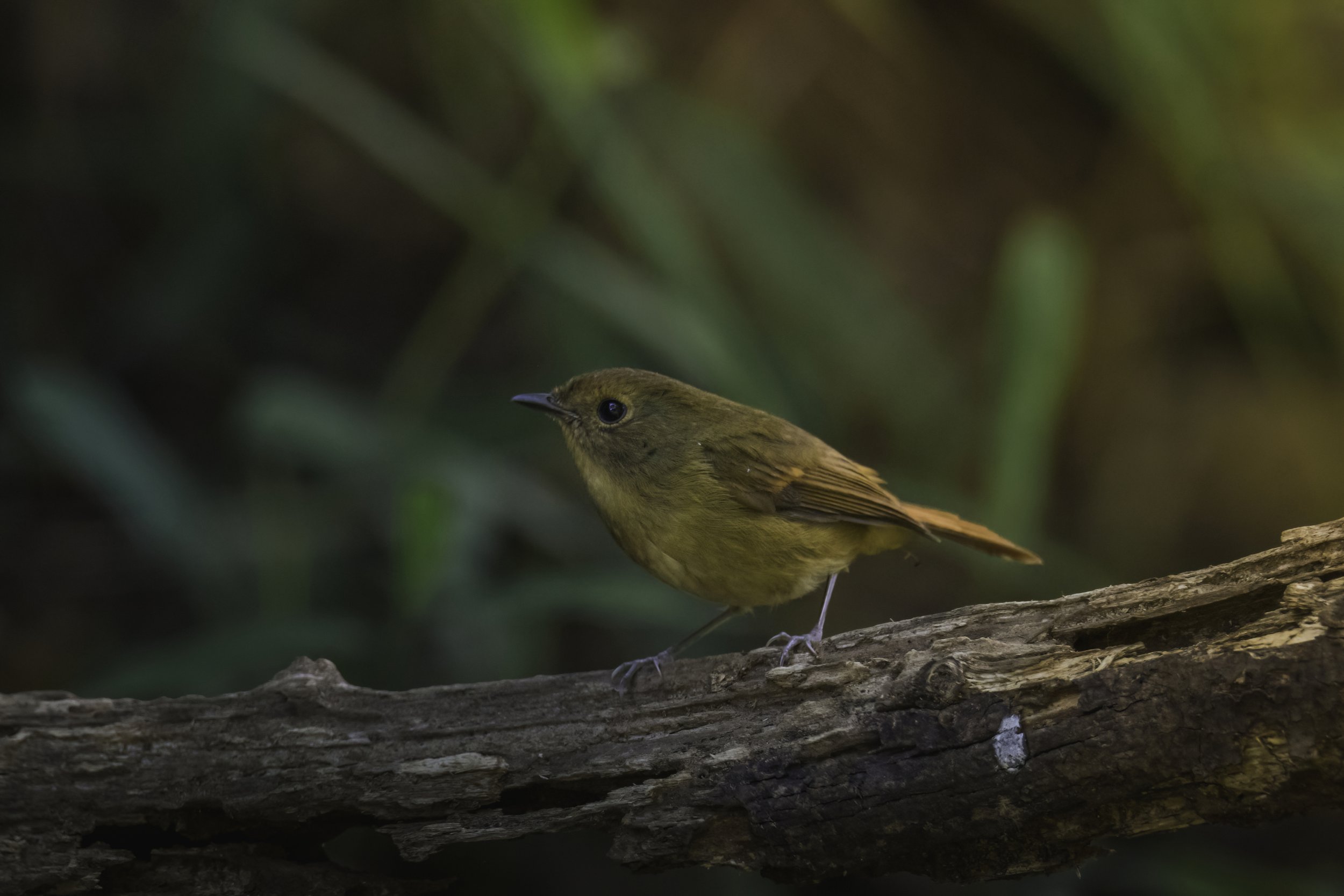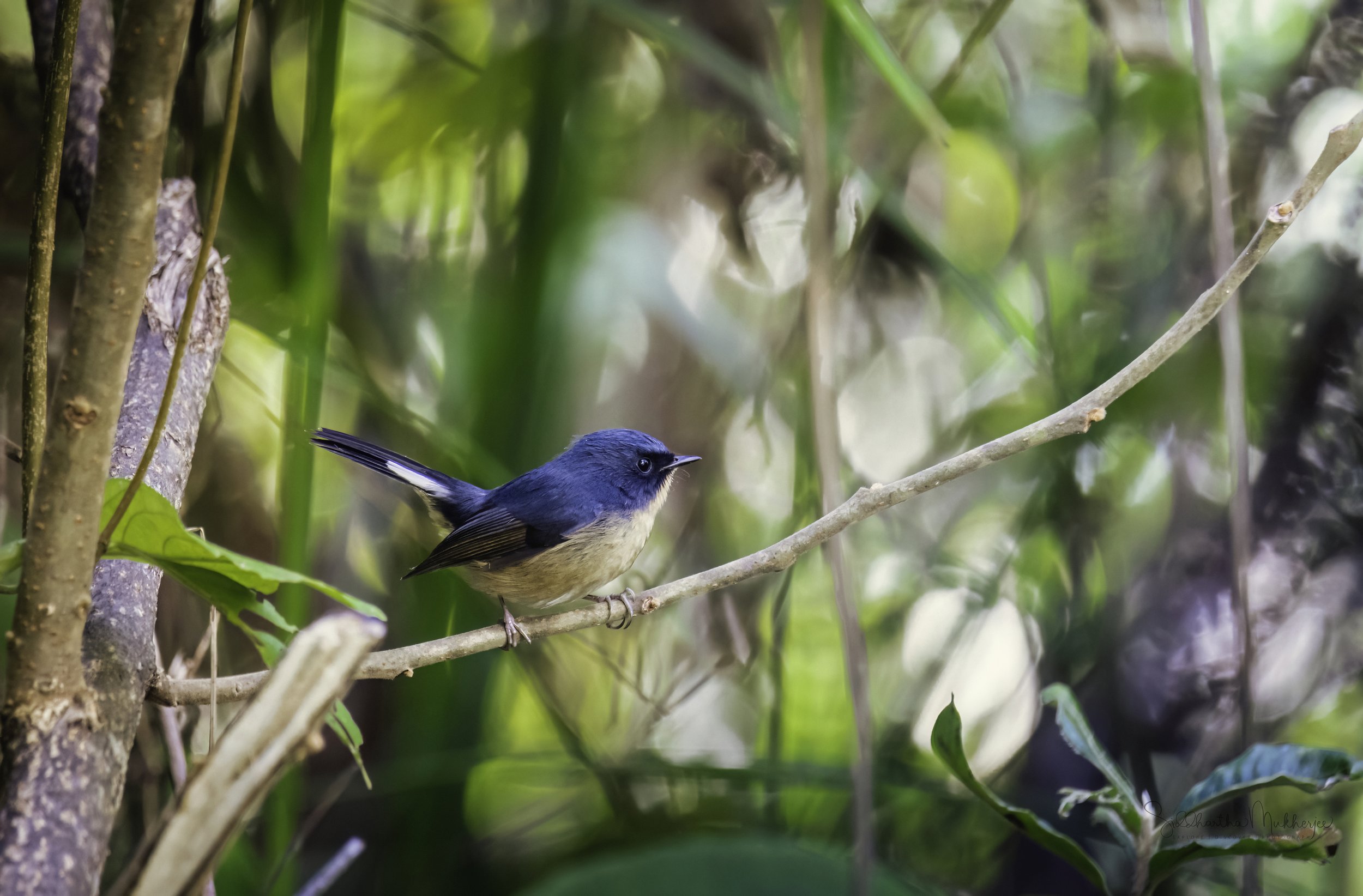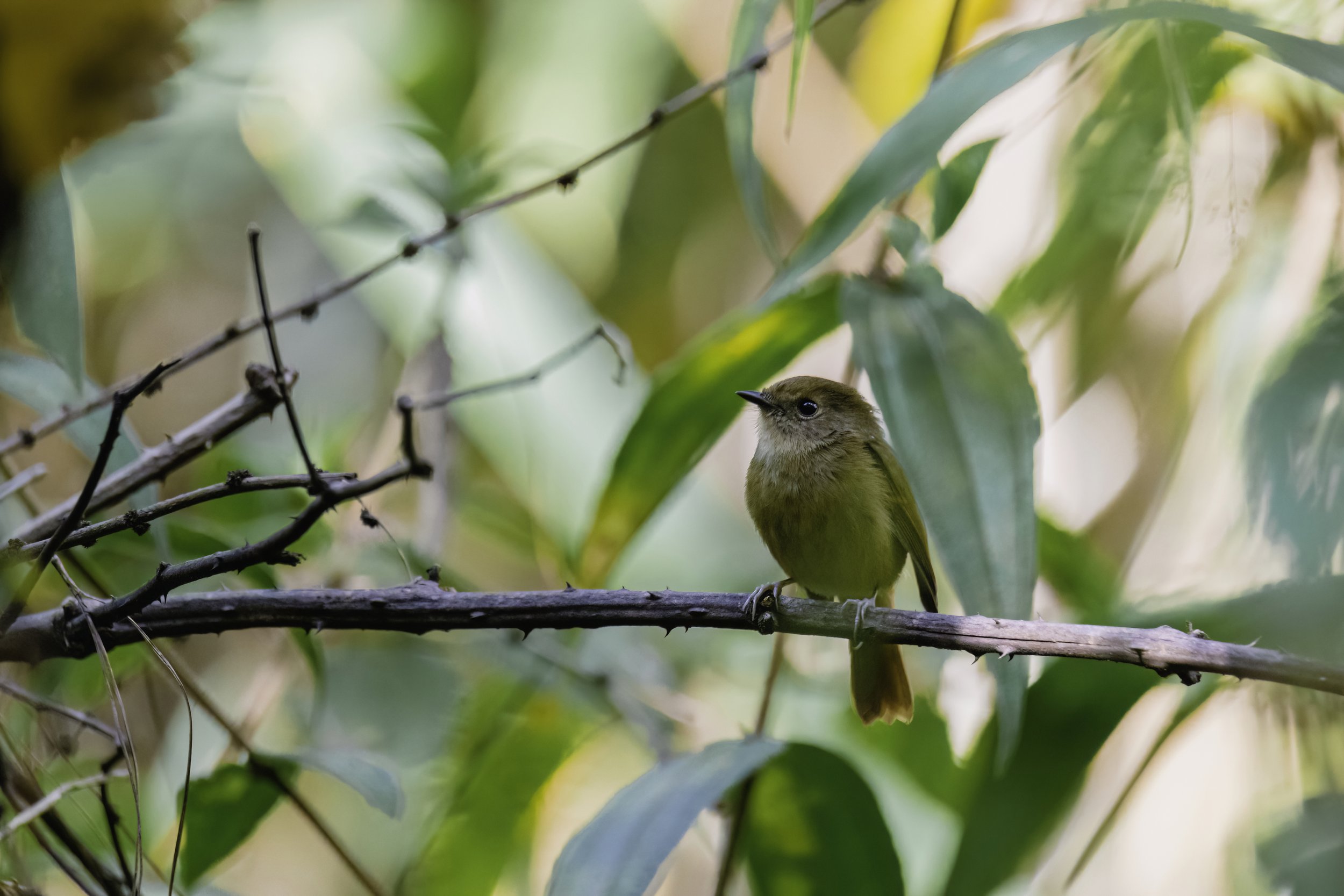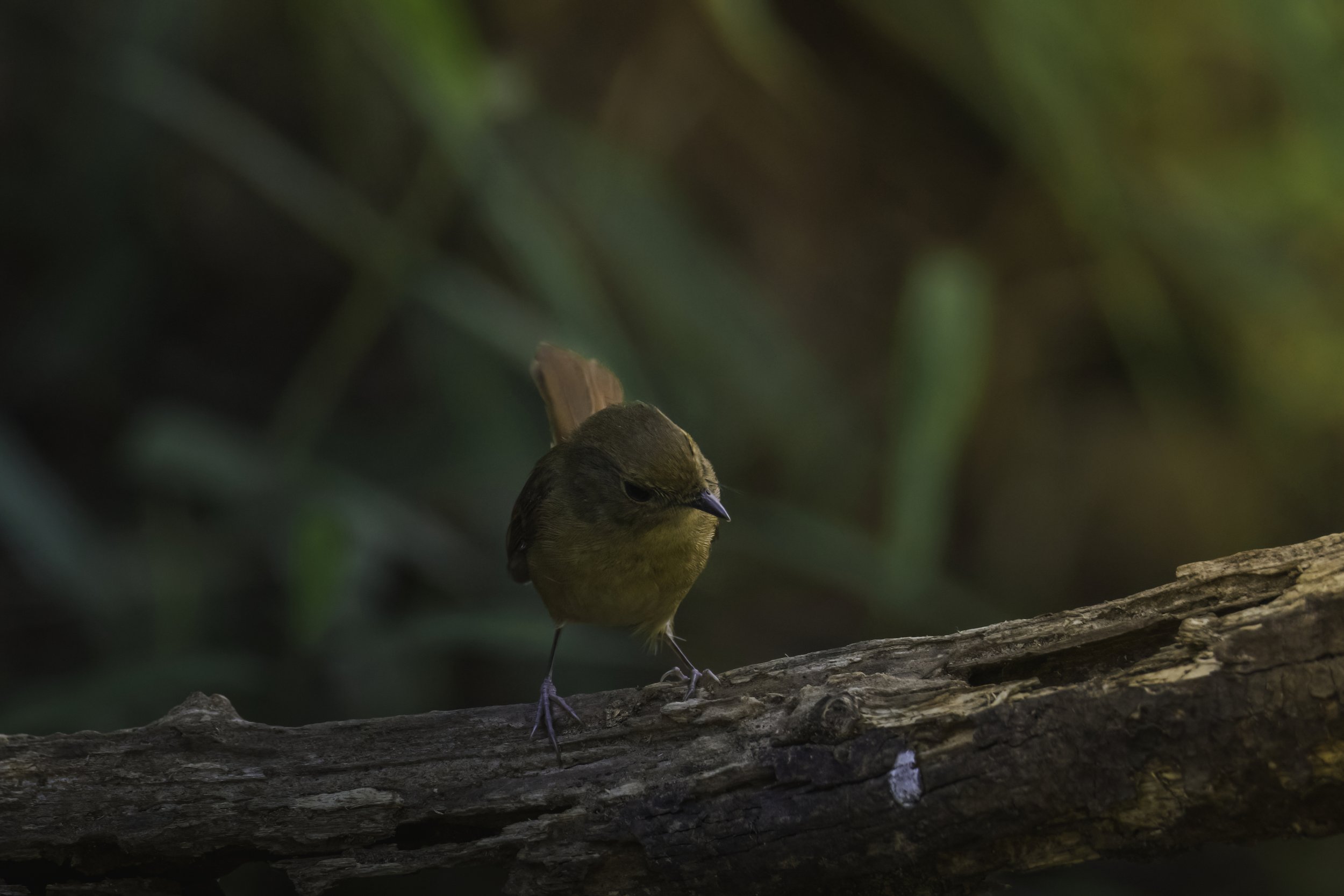Slaty-blue Flycatcher
Ficedula tricolor
Doi Luang, Chiang Mai, Thailand
It has been a while since I talked about a flycatcher. I think the last flycatcher I did was the gorgeous Rufous-gorgeted Flycatcher. Read about all my other Flycatchers and related species.
The Slaty-blue is also a part of the large family of Old World flycatchers, the Muscicapidae, a group of small passerine birds mostly restricted to the Old World (Europe, Africa and Asia), and a bird very similar to the White-gorgeted Flycatcher and the Rufous-browed Flycatcher. These are mainly small arboreal insectivores, many of which, as the name implies, take their prey on the wing. The family includes 344 species and is divided into 51 genera. Old World flycatchers live in almost every environment with a suitable supply of trees, from dense forest to open scrub, & even the montane woodland of the Himalayas. The more northerly species migrate south in winter, ensuring a continuous diet of insects.
The appearance of these birds is very varied, but they mostly have weak songs and harsh calls. They are small to medium birds, ranging from 9 to 22 cm in length. Many species are dull brown in colour, but the plumage of some can be much brighter, especially in the males. Most have broad, flattened bills suited to catching insects in flight, although the few ground-foraging species typically have finer bills. Depending on the species, their nests are either well-constructed cups placed in a tree or cliff ledge, or simply lining in a pre-existing tree hole. The hole-nesting species tend to lay larger clutches, with an average of eight eggs, rather than just two to five.
Slaty-blue Flycatcher (Male)
But first about where I first saw this beautiful flycatcher - the spectacular mountains of Northern Thailand. The Dois of northern Thailand have been very kind to me from a birding perspective. There are so many I have already talked about and so many still remaining. I have written an overview here on the Birds of the Dois and have now started to break them up into individuals like the Gray-backed Shrike, Long-tailed Shrike, Spectacled Barwing, Siberian Rubythroat, the stunning Mrs. Gould’s Sunbird and the numerous other birds I have seen here.
About 685 kilometers to the north of Bangkok lies the former seat of the ancient Lanna Kingdom and is considered one of the most scenic provinces in the country given its mountain ranges, valleys, flora and fauna. A land of misty mountains and colourful hill tribes, a playground for seasoned travellers, and a delight for adventurers. Despite its relatively small size and blissful calm, Chiang Mai truly has it all, a city that is still firmly Thai in its atmosphere and attitude. It is the second-largest changwat (province) of Thailand. Bordered by Chiang Rai to the northeast, Lampang and Lamphun to the south, Tak to the southwest, Mae Hong Son to the west and the Shan State of Myanmar to the north. Located in a verdant valley on the banks of the Ping River, Chiang Mai was founded in 1296 as the capital of the ancient Lanna Kingdom. Today it is a place where past and the present seamlessly merge with modern buildings standing side by side with venerable temples. Of all the places I have visited in Thailand, Chiang Mai with its forests and mountains and the historic city of Ayutthaya are by far my favourites.
The word Chiang itself is from North Thai, or Lanna, meaning town or city and Mai means new making Chiang Mai the New City as it was founded later than Chiang Rai, the earlier capital of King Meng Rai. The districts in the province are called amphoe, and sub-districts are called tambon. Another twist is the use of Nakhon (or Nakorn or Nakhorn), derived from the Sanskrit word Nagara, also means city, though strictly speaking it refers to a capital city such as Nakorn Sri Ayutthaya (more on Ayutthaya later). Indeed to emphasise its former status you may sometimes see Chiang Mai referred to as Nakhon Ping. Other common names of geographical features include mae (river) and doi which is north Thai for mountain - for example Doi Inthanon and Mae Ping.
The four Dois we spent our time on were Doi Inthanon, Doi Ang Khang, Doi Luang and Doi SanJu.
Doi Luang & Doi SanJu in close proximity to the Doi Pha Hom Pok National Park, it is the second highest mountain in Thailand and a part of the Dan Lao Mountain range, northwest of Chiang Mai, sharing the border with Myanmar. Doi SanJu, can be easily accessed from Fang town. The mountain forest and no traffic make it easy to view birds. The entire area is very quiet, secluded and home to rare species like Mrs. Humes Pheasant, Long–tailed Sibia, Himalayan Cutia, Black–throated Tit, Black–eared Shrike Babbler, Whiskered Yuhina, Crimson–breasted Woodpecker, Fire–tailed Sunbird to name a few.
We didn’t have the good fortune to see all the species on all the mountains, that would have been impossible, but we did rack up quite a number of species - about 95 of them. This gallery is of the tiny, unobtrusive and retiring White-gorgeted Flycatcher who keeps to the dense lower levels of foothill forests.
Read about the other birds from these beautiful mountains. These are only a few of the huge number I have spotted and recorded there.
With that said, meet this lovely little flycatcher from the mountains of Chiang Mai, one of many I have seen there.
‡‡‡‡‡
Slaty-blue Flycatcher (Female)
Slaty-Blue Flycatcher
The Slaty-blue Flycatcher (Ficedula tricolor) is a species of bird in the family Muscicapidae found in the Indian Subcontinent and Southeast Asia, ranging across Bangladesh, Bhutan, India, Laos, Myanmar, Nepal, Pakistan, Thailand, and Vietnam. Its natural habitat is subtropical or tropical moist montane forests.
The male is a unique dark gray-blue above with a white throat, thin black chinstrap, and white undersides and tail base (often flashed when in flight). The female is plainer, dark brown above and lighter tan brown below, with a rufous-tinged tail; weak contrast and overall dark coloration distinguish her from other brown female flycatchers. They breed in high-altitude and foothill forests and descends downhill to winter in scrubby areas, often in second growth and often forages close to the ground. The song consists of an endless series of high, whistled “chee-chee-wit!”, often given from a low, hidden perch. Also gives hard, resonant “tak” notes. The juvenile is similar to the female or slightly darker brown, including tail, but upperparts, including wing-coverts, heavily spotted warm buff and streaked pale buff, and underparts barred or scaled darker on breast; first-year more like respective adult, but with thin rufous-buff tips on greater coverts. The race minuta male has slightly darker blue upperparts than nominate, and warm buffish-olive underparts, pinkish base of lower mandible, also pinkish-brown legs, female is deep olive-brown above, tipped rufous on rump and tail, dull rufous upper throat becoming pale buff on lower throat, with side of neck, breast and upper belly dingy brownish-buff; diversa male has dull slate-blue upperparts, buffish-grey chin and throat, female more olive on upperparts and breast band than nominate; cerviniventris male has underparts warm buff with bluish breast band, female has darker warm rufous upperparts contrasting less with rump and tail, also warm buff below.
Four subspecies are recognised:
Ficedula tricolor tricolor - Distributed in the West and Central Himalayas of North Pakistan and Kashmir East to Central Nepal and SW Tibet; non-breeding at lower altitudes.
Ficedula tricolor minuta - Distributed in the Himalayas from Central and East Nepal East to North East India (Arunachal Pradesh and W Assam) and South East Tibet; non-breeding at lower altitudes, including Assam Valley and Bangladesh.
Ficedula tricolor cerviniventris - Distributed in North East India (Meghalaya, East Nagaland and SE Assam South to Mizoram) and West Myanmar; non-breeding in North East Bangladesh.
Ficedula tricolor diversa - Distributed in Central China (South Gansu South to Yunnan), West and North Myanmar; non-breeding S China (S Yunnan), East Myanmar, North West Thailand, North Laos and North Vietnam.
The Slaty-blue Flycatcher breeds in subalpine shrubberies, bush-covered hills (particularly with Viburnum nervosum and Salix denticulata) with bamboo and forest edges in the Himalayas; in undergrowth of moist oak-rhododendron (Quercus-Rhododendron) or conifer forests farther East; between 2600 m and 3300 m in North Pakistan and at 1800–3400 m elsewhere in West Himalayas and 2700–4000 m in East, but down to 1500 m in North East Indian hill states. Outside breeding season found in thick bush-covered slopes, ravines, forest undergrowth, also tall grass, reed beds and sugar-cane fields, at lower levels, 460–1500 in Pakistan, 160–2135 m in Nepal and generally below 1200 m in N India. It is an altitudinal migrant, making post-breeding descent to lower altitudes, departing breeding areas from end Jul to end Nov, and returning again mid-Feb to end Apr. They are a passage migrant through South China (Guizhou) and North Vietnam (East Tonkin), and scarce winter visitor in NW Thailand (above 1200 m), and a vagrant to NW & NE China.
Their food includes small invertebrates, in particular centipedes (Chilopoda), midges (Chironomidae), beetles (Coleoptera). Usually seen solitary or in pairs, actively foraging and skulking low down in trees, shrubs and undergrowth, also on the ground. They watch from low perches and pounce on insects on the ground sometimes also making a short aerial pursuit of insects. They have an almost horizontal stance with drooping wings and often flicking their tail over their backs.
Their song, usually heard from a well-concealed low perch (continuously during day, also often at night), consists of 3–4 high-pitched whistles, the first drawn out, the second louder and running into a trill, “chreet-chrr-whit-it”. Also a rolling “trrri trrri trrri…” and a rapid “tic-tic” or “tek-tek-tek” call. The alarm is a shrill “chreet-tic-tic-tic”, usually accompanied by tail-flicking.
The breeding season is between April and July and the nest is a cup of moss, plant fibres, animal hair, feathers and gossamer, placed in depression on ground in bank, or 2–6 m up in hole in tree trunk, wall or among boulders usually with a clutch of 3–4 eggs incubated by the female and fed at the nest by the male.
They are not a globally threatened species and are listed as Least Concern. Commonly found in West & North West Himalayas, local in Central & East Nepal, locally common in North East India and Assam and fairly common to uncommon in China, N Myanmar and N Vietnam. In N Pakistan, with densities of 3–4 breeding pairs within 100 m of each other.
The following gallery of the Slaty-blue flycatcher is of birds observed and photographed in and around Doi Luang near Chiang Mai.
‡‡‡‡‡
Related Posts




















